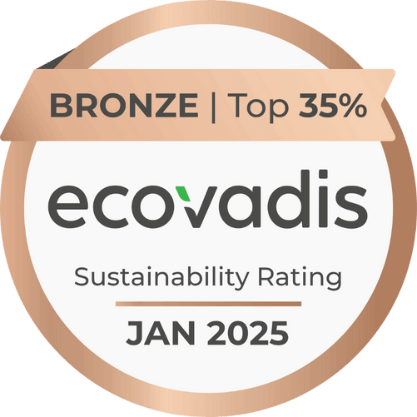Semiconductor Sustainability: Six-Month 2025 Recap — From Clean Energy to Carbon Transparency
7 Min Read July 7, 2025
The semiconductor industry has faced a confusing sustainability landscape over the first half of the year.
![]()
The semiconductor industry has faced a confusing sustainability landscape over the first half of the year. However, despite headwinds at a macro level, the semiconductor industry remains focused on progress towards sustainability goals. From ambitious carbon reduction targets at top foundries to data-driven tools that benchmark emissions, the sector is accelerating toward transparency and lower environmental impact. Here's a look at five 2025 developments shaping the future of green chipmaking:
TSMC Commits to SBTi Carbon Targets
In April 2025, TSMC announced its formal commitment to the Science Based Targets initiative (SBTi), reinforcing its adherence to its emissions strategy. The company aims to peak its carbon emissions by 2025, revert to 2020 levels by 2030, and achieve net-zero by 2050. Key interim goals include sourcing 60% of electricity from renewables by 2030, reaching RE100 by 2040, and securing Scope 3 emissions reductions through a pioneering 20-year renewable energy procurement partner program. Additionally, TSMC's support of over 50 suppliers through its GREEN agreement strengthens its supply chain emissions responsibility and promises to further reduce semiconductor carbon footprints.
Applied Materials Releases Playbook for Sustainable Energy for AI
A recent report from a semiconductor leader outlines a compelling case for how Artificial Intelligence (AI), underpinned by advanced semiconductor technology, could become a key lever for addressing structural economic challenges—namely, slowing workforce growth and rising sovereign debt across major global economies. The Applied Materials report highlights that AI’s potential to boost productivity at scale could help stabilize living standards, improve income distribution, and support geopolitical stability. However, realizing this potential will require significant changes to the global energy landscape.
Using data from trusted sources that include TechInsights, the report emphasizes that the energy demands of large-scale AI computing cannot be met simply by adding new clean energy sources or scaling existing ones; instead, a holistic restructuring of the power grid is necessary to deliver sustainable, abundant energy.
According to the report, a narrow focus on emissions or renewable energy alone risks creating an unstable energy ecosystem. The report proposes a three-pronged strategy for enabling sustainable AI growth:
- Decarbonizing the grid,
- Enhancing the energy efficiency of computing,
- Unlocking new semiconductor value streams.
Grid decarbonization involves boosting energy generation capacity, modernizing the grid infrastructure, and shifting toward cleaner energy sources. On the computing side, efficiency gains must be achieved through optimized chip architectures, manufacturing processes, and strategic fab placement near abundant low-carbon energy. The report also calls for new collaborative models across the semiconductor value chain to accelerate innovation. This approach reframes sustainability not as a limitation, but as a driver of resilience and opportunity in the era of AI.
Semiconductor Climate Consortium Launches 2025 Initiatives
In March 2025, the Semiconductor Climate Consortium released four strategic initiatives aimed at driving industry-wide decarbonization. Its roadmap includes:
- Standardized emissions and energy reporting guidelines
- Sharing of proven GHG abatement technologies
- Renewables procurement acceleration
- Energy efficiency best-practice exchange among fabs that are members of semi.org.
These efforts will continue to pave the way for improved transparency and cross-industry collaboration.
Alarming Semiconductor Manufacturing Emissions Forecast Published by TechInsights
TechInsights’ “Global Semiconductor Carbon Emissions Forecast, 2025-2030" report warns that, without intervention, industry emissions are projected to grow 8.3% annually — reaching 277 million metric tons of CO₂e by 2030. The report also highlights that silicon fabrication “intensity”—the emissions tied to die production—will continue to dominate carbon impact, suggesting emissions mitigation must be embedded at the process and design level.
Navitas Unveils 800V HVDC Architecture to Boost AI Data Center Efficiency, Cut Copper Waste
Navitas Semiconductor in May announced its next-generation 800V high-voltage DC (HVDC) architecture to support NVIDIA's Kyber rack-scale AI systems, including the NVIDIA Rubin Ultra platform. This breakthrough enables more efficient, scalable power delivery for energy-hungry AI data centers, significantly reducing copper usage and infrastructure complexity. Compared to legacy 54V systems, the 800V HVDC approach minimizes I²R losses, cutting copper requirements by up to 45%, crucial as data centers scale to gigawatt power levels. Enabled by Navitas’ advanced GaNFast and GeneSiC technologies, this innovation improves reliability, efficiency, and sustainability for the future of AI infrastructure.
Why This Matters
These developments collectively underscore three 2025 trends:
- Carbon targets are getting real: Leading foundries are now backed by SBTi targets and large-scale renewables agreements.
- Transparency isn’t optional: Data tools like the TechInsights EcoInsights sustainability tool are raising the bar for fact-based and specific emissions reporting for the semiconductor industry
- Materials matter: 800V high-voltage DC (HVDC) architecture is a breakthrough that enables more efficient, scalable power delivery for energy-hungry AI data centers.
For semiconductor manufacturers, the writing is on the wafer: Awareness of the carbon impact must be embedded in every stage of design and manufacturing process step.
What’s Next?
- TSMC’s SBTi roadmap sets a global precedent—others will likely follow closely
- Expect more renewable energy investments, and supply chain synergies across the industry
- As forecasting warns of growing emissions, data tools for carbon modeling, comparison, and forecasting are critical to help understand hotspots and drive mitigation strategies for the long term
Those who embed carbon intelligence now will shape the next generation of sustainable semiconductors.
Stay tuned for our upcoming case studies and podcast on how leading fabs are deploying EcoInsights to operationalize these trends.










